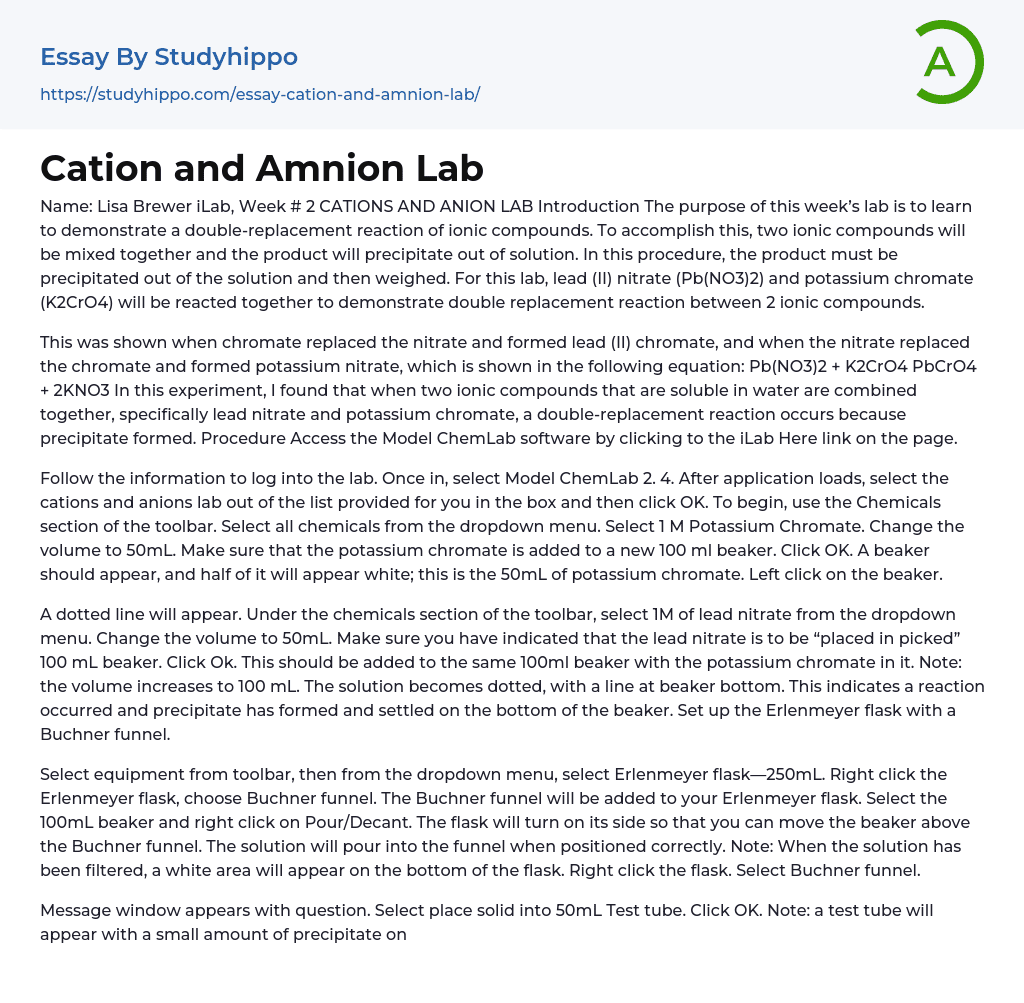The purpose of this week’s lab is to learn to demonstrate a double-replacement reaction of ionic compounds. To accomplish this, two ionic compounds will be mixed together and the product will precipitate out of solution. In this procedure, the product must be precipitated out of the solution and then weighed. For this lab, lead (II) nitrate (Pb(NO3)2) and potassium chromate (K2CrO4) will be reacted together to demonstrate double replacement reaction between 2 ionic compounds.
This was shown when chromate replaced the nitrate and formed lead (II) chromate, and when the nitrate replaced the chromate and formed potassium nitrate, which is shown in the following equation: Pb(NO3)2 + K2CrO4 PbCrO4 + 2KNO3
In this experiment, I found that when two ionic compounds that are soluble in water are com
...bined together, specifically lead nitrate and potassium chromate, a double-replacement reaction occurs because precipitate formed. Procedure Access the Model ChemLab software by clicking to the iLab Here link on the page.
Follow the information to log into the lab. Once in, select Model ChemLab. After application loads, select the cations and anions lab out of the list provided for you in the box and then click OK. To begin, use the Chemicals section of the toolbar. Select all chemicals from the dropdown menu. Select 1 M Potassium Chromate. Change the volume to 50mL. Make sure that the potassium chromate is added to a new 100 ml beaker. Click OK. A beaker should appear, and half of it will appear white; this is the 50mL of potassium chromate. Left click on the beaker.
A dotted line will appear. Under the chemicals section o
the toolbar, select 1M of lead nitrate from the dropdown menu. Change the volume to 50mL. Make sure you have indicated that the lead nitrate is to be “placed in picked” 100 mL beaker. Click Ok. This should be added to the same 100ml beaker with the potassium chromate in it. Note: the volume increases to 100 mL. The solution becomes dotted, with a line at beaker bottom. This indicates a reaction occurred and precipitate has formed and settled on the bottom of the beaker. Set up the Erlenmeyer flask with a Buchner funnel.
Select equipment from toolbar, then from the dropdown menu, select Erlenmeyer flask—250mL. Right click the Erlenmeyer flask, choose Buchner funnel. The Buchner funnel will be added to your Erlenmeyer flask. Select the 100mL beaker and right click on Pour/Decant. The flask will turn on its side so that you can move the beaker above the Buchner funnel. The solution will pour into the funnel when positioned correctly. Note: When the solution has been filtered, a white area will appear on the bottom of the flask. Right click the flask. Select Buchner funnel.
Message window appears with question. Select place solid into 50mL Test tube. Click OK. Note: a test tube will appear with a small amount of precipitate on the bottom. To measure the weight of the precipitate, right click the test tube. Select show weight. The weight of the precipitate will appear below the test tube. Record this information in the Observations and Results section of the lab report, including the weight and appearance of the precipitate.
Observations and Results
The appearance of the precipitate
was shown several ways during the experiment. In the 100mL beaker, after both chemicals were added, it was shown as a dotted solution. It was then shown as a solid and a white color in the Erlenmeyer flask; however when it was placed in the test tube the color of the precipitate was yellow. The yellow color indicated that there was indeed a reaction that occurred. The filtered precipitate weighed 16. 160g.
Discussion
In this experiment, for the ionic compound lead (II) nitrate, the anion was the nitrate and the cation was the lead. For the ionic compound potassium chromate, the anion was the chromate and the cation was the potassium.
Lead and potassium has a positive charge and are only able to react with a molecule that is negatively charged. So, lead can only can only react to the chromate in this instance and potassium can only react with the anion, nitrate. The anion and cations switch and replace each other to form lead chromate and potassium nitrate.
Conclusion
In conclusion, when you mix two ionic compounds together that are soluble in water, specifically lead nitrate and potassium chromate, it creates a double–replacement reaction and results in a precipitate being formed. I found that the product of the precipitate weighed 16. 160g.
- John Locke essays
- 9/11 essays
- A Good Teacher essays
- A Healthy Diet essays
- A Modest Proposal essays
- A&P essays
- Academic Achievement essays
- Achievement essays
- Achieving goals essays
- Admission essays
- Advantages And Disadvantages Of Internet essays
- Alcoholic drinks essays
- Ammonia essays
- Analytical essays
- Ancient Olympic Games essays
- APA essays
- Arabian Peninsula essays
- Argument essays
- Argumentative essays
- Art essays
- Atlantic Ocean essays
- Auto-ethnography essays
- Autobiography essays
- Ballad essays
- Batman essays
- Binge Eating essays
- Black Power Movement essays
- Blogger essays
- Body Mass Index essays
- Book I Want a Wife essays
- Boycott essays
- Breastfeeding essays
- Bulimia Nervosa essays
- Business essays
- Business Process essays
- Canterbury essays
- Carbonate essays
- Catalina de Erauso essays
- Cause and Effect essays
- Cesar Chavez essays
- Character Analysis essays
- Chemical Compound essays
- Chemical Element essays
- Chemical Substance essays
- Cherokee essays
- Cherry essays
- Childhood Obesity essays
- Chlorine essays
- Classification essays
- Cognitive Science essays




